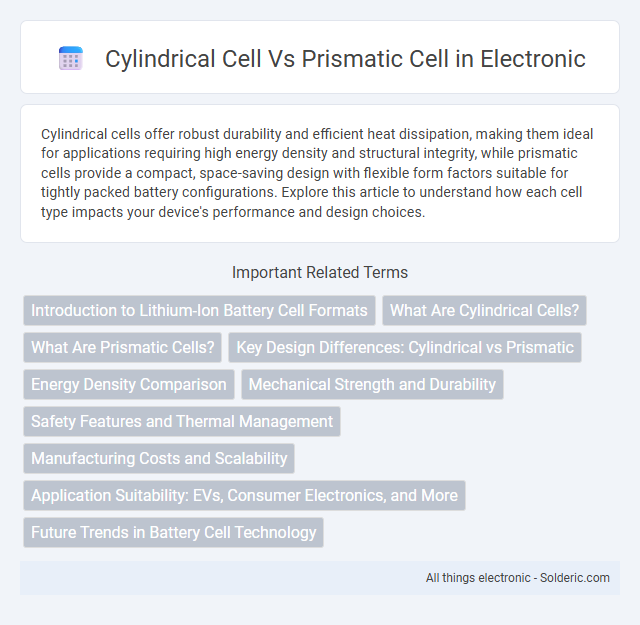Cylindrical cells offer robust durability and efficient heat dissipation, making them ideal for applications requiring high energy density and structural integrity, while prismatic cells provide a compact, space-saving design with flexible form factors suitable for tightly packed battery configurations. Explore this article to understand how each cell type impacts your device's performance and design choices.
Comparison Table
| Feature | Cylindrical Cell | Prismatic Cell |
|---|---|---|
| Shape | Round, tube-like | Rectangular, flat |
| Energy Density | Moderate (100-265 Wh/kg) | Higher (150-300 Wh/kg) |
| Cooling Efficiency | Less efficient due to shape | More efficient, easier to cool |
| Manufacturing Cost | Lower, standardized production | Higher, complex process |
| Mechanical Stability | Robust against pressure | Less mechanically stable, prone to swelling |
| Applications | Power tools, electric vehicles | Electric vehicles, large battery packs |
| Size Flexibility | Limited to standard sizes | Custom shapes and sizes possible |
| Cycle Life | Good, stable | Variable, depends on design |
Introduction to Lithium-Ion Battery Cell Formats
Lithium-ion battery cell formats primarily include cylindrical and prismatic cells, each designed to optimize energy density and mechanical stability. Cylindrical cells feature a wound electrode structure providing excellent thermal management and durability, widely used in power tools and electric vehicles. Prismatic cells, with their flat and rectangular shape, offer greater space efficiency and easier integration into compact devices like smartphones and laptops.
What Are Cylindrical Cells?
Cylindrical cells are a type of rechargeable battery characterized by their round, tube-like shape, commonly used in applications such as laptops, power tools, and electric vehicles. Their metal casing provides excellent mechanical stability and efficient heat dissipation, making them suitable for high-drain devices. Popular cylindrical cell sizes include 18650 and 21700, which are widely adopted in battery packs for consumer electronics and electric mobility.
What Are Prismatic Cells?
Prismatic cells are rechargeable batteries encased in a rectangular, flat, or square-shaped metal or aluminum casing, designed to maximize space efficiency in electronic devices and electric vehicles. These cells offer better packing density compared to cylindrical cells, allowing for more compact battery modules and improved energy storage capacity. Your device benefits from prismatic cells due to their customizable size and shape, which optimize battery integration and thermal management.
Key Design Differences: Cylindrical vs Prismatic
Cylindrical cells feature a round, metal can design offering robust structural integrity and efficient thermal management, ideal for high-drain applications. Prismatic cells have a rectangular, flat pouch-like casing that allows for higher energy density and flexible packaging, optimizing space utilization in compact devices. Your choice between these formats depends on device requirements, balancing durability and energy density.
Energy Density Comparison
Cylindrical cells generally offer higher energy density due to their efficient packing and uniform pressure distribution, which enhances thermal management and longevity. Prismatic cells provide better space utilization within devices but often have slightly lower energy density because of structural limitations and added packaging materials. When optimizing Your device's energy storage, cylindrical cells typically deliver more power per unit volume, while prismatic cells prioritize form factor flexibility.
Mechanical Strength and Durability
Cylindrical cells offer superior mechanical strength due to their uniform shape and robust metal casing, which enhances pressure resistance and impact durability. Prismatic cells, with their flat, rectangular design, are more susceptible to swelling and mechanical deformation under stress, potentially reducing long-term durability. High-performance applications often favor cylindrical cells for environments requiring enhanced structural integrity and consistent load resistance.
Safety Features and Thermal Management
Cylindrical cells feature robust metal casings that enhance mechanical stability and improve heat dissipation, reducing the risk of overheating and thermal runaway, while prismatic cells offer larger surface areas for integrated cooling systems, promoting efficient thermal management in compact designs. Prismatic cells often incorporate advanced safety mechanisms like pressure relief vents and internal partitions to prevent swelling and short circuits, providing enhanced safety in tight spaces. Your choice between these cell types should consider the balance between thermal management efficiency and built-in safety features to optimize battery performance and longevity.
Manufacturing Costs and Scalability
Cylindrical cells typically have lower manufacturing costs due to their standardized design and widespread production infrastructure, enabling efficient mass production and scalability. Prismatic cells, while often more expensive to produce because of their complex casing and assembly processes, offer better space utilization and customization for specific applications. Your choice depends on balancing cost efficiency with design flexibility and the intended scale of battery deployment.
Application Suitability: EVs, Consumer Electronics, and More
Cylindrical cells are highly suitable for applications requiring robust structural integrity and efficient thermal management, such as electric vehicles (EVs) and power tools, due to their standardized size and high durability. Prismatic cells, favored in consumer electronics and larger EV battery packs, offer flexible design options and higher energy density within a compact form factor, enabling better space utilization. Your choice between these cell types will depend on the specific application needs, balancing energy density, durability, and space constraints.
Future Trends in Battery Cell Technology
Future trends in battery cell technology emphasize improvements in energy density, thermal management, and manufacturing scalability for both cylindrical and prismatic cells. Cylindrical cells benefit from advanced winding techniques and optimized materials, enhancing performance in electric vehicles and portable electronics. Prismatic cells are evolving with innovative electrode designs and flexible packaging, offering better space efficiency and integration for your next-generation battery applications.
Cylindrical cell vs Prismatic cell Infographic

 solderic.com
solderic.com